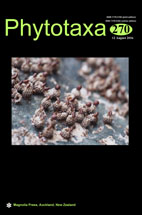Abstract
Fungal isolates GZUIFR-EM14.2002 and GZUIFR-EM66601 were respectively isolated from Chinese soil samples under the snake skin in Guizhou Province and from the soil samples under the feathers in Hubei Province, China. Morphological and molecular evidence support both isolates as new species of Chrysosporium. Phylogenetic analysis based on ITS-5.8S rDNA sequences grouped GZUIFR-EM14.2002 together with C. lucknowense and C. mephiticum. GZUIFR-EM14.2002, which could be distinguished from the latter two species by the presence of abundant intercalary conidia, was named C. guizhouense sp. nov. In the phylogenetic tree, GZUIFR-EM66601 was most closely related to C. submersum and C. siglerae, GZUIFR-EM66601 differed from the other two species in having small obovate to ellipsoidal conidia and no intercalary conidia; this strain was designated as C. hubeiense sp. nov. Holotypes and their isolates had been deposited in GZAC, Guiyang, Guizhou Province, China.

